University Finance Assignment: Revaluation and Impairment Testing
VerifiedAdded on 2022/10/11
|7
|1533
|15
Report
AI Summary
This report provides a comprehensive analysis of asset revaluation and impairment testing, covering key aspects such as fair value measurement, the application of AASB 13, and the advantages and disadvantages of different valuation methods. The report explores the determination of fair value, considering the role of market participants and transaction costs. It contrasts the cost model with the revaluation model, highlighting the advantages of each. Furthermore, the report delves into the concept of Cash Generating Units (CGUs) and their significance in impairment testing, particularly in the context of a bus company, illustrating how CGUs are determined and utilized to assess the recoverable amount of assets. The report concludes that CGUs are important components of a bus riding company and are superior over a single asset. The report also discusses the disadvantages of using historical costs for depreciation, and the advantages of using the cost model over the revaluation model. The report provides a detailed overview of the relevant accounting standards and their practical application.
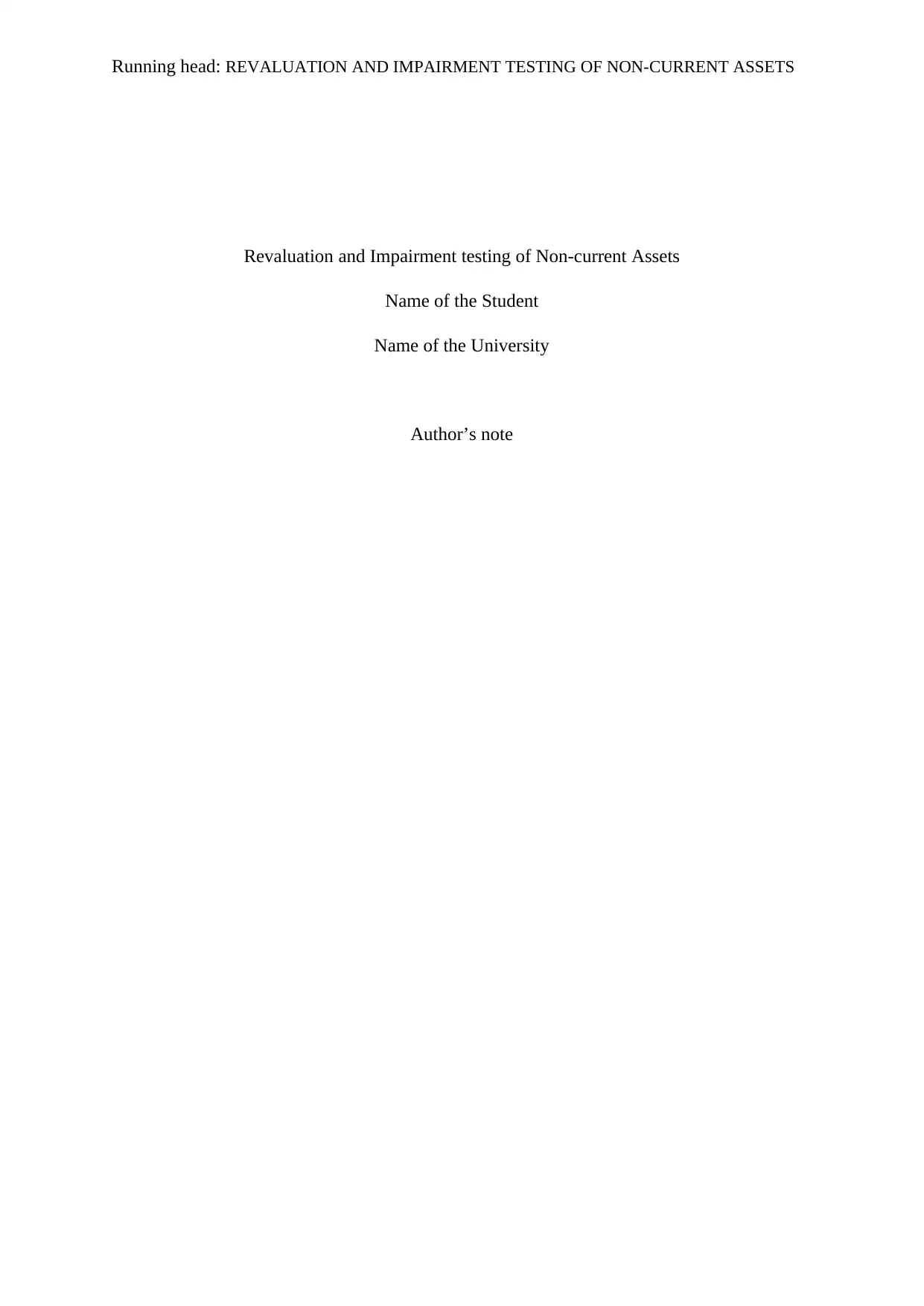
Running head: REVALUATION AND IMPAIRMENT TESTING OF NON-CURRENT ASSETS
Revaluation and Impairment testing of Non-current Assets
Name of the Student
Name of the University
Author’s note
Revaluation and Impairment testing of Non-current Assets
Name of the Student
Name of the University
Author’s note
Paraphrase This Document
Need a fresh take? Get an instant paraphrase of this document with our AI Paraphraser
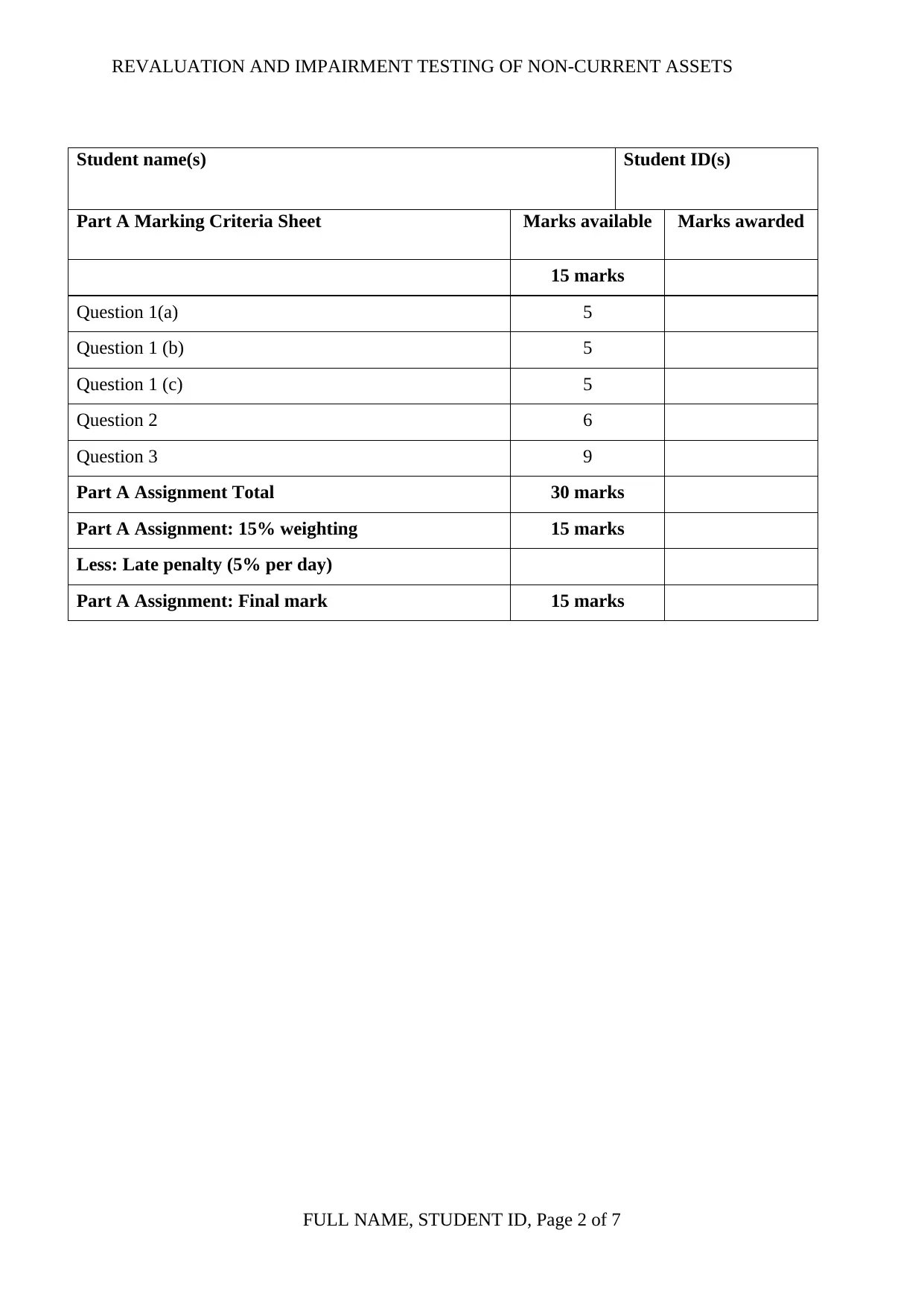
REVALUATION AND IMPAIRMENT TESTING OF NON-CURRENT ASSETS
Student name(s) Student ID(s)
Part A Marking Criteria Sheet Marks available Marks awarded
15 marks
Question 1(a) 5
Question 1 (b) 5
Question 1 (c) 5
Question 2 6
Question 3 9
Part A Assignment Total 30 marks
Part A Assignment: 15% weighting 15 marks
Less: Late penalty (5% per day)
Part A Assignment: Final mark 15 marks
FULL NAME, STUDENT ID, Page 2 of 7
Student name(s) Student ID(s)
Part A Marking Criteria Sheet Marks available Marks awarded
15 marks
Question 1(a) 5
Question 1 (b) 5
Question 1 (c) 5
Question 2 6
Question 3 9
Part A Assignment Total 30 marks
Part A Assignment: 15% weighting 15 marks
Less: Late penalty (5% per day)
Part A Assignment: Final mark 15 marks
FULL NAME, STUDENT ID, Page 2 of 7
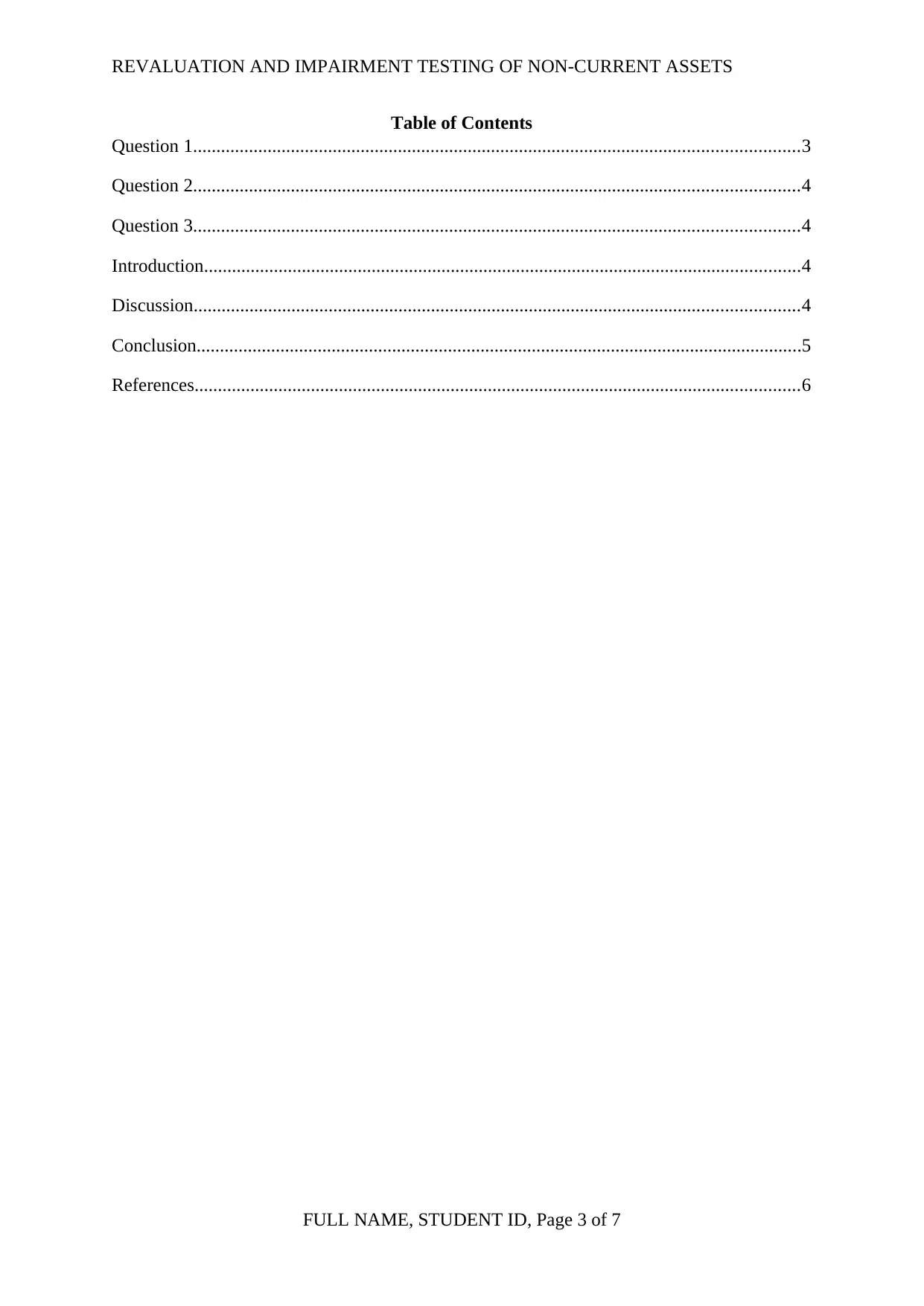
REVALUATION AND IMPAIRMENT TESTING OF NON-CURRENT ASSETS
Table of Contents
Question 1..................................................................................................................................3
Question 2..................................................................................................................................4
Question 3..................................................................................................................................4
Introduction................................................................................................................................4
Discussion..................................................................................................................................4
Conclusion..................................................................................................................................5
References..................................................................................................................................6
FULL NAME, STUDENT ID, Page 3 of 7
Table of Contents
Question 1..................................................................................................................................3
Question 2..................................................................................................................................4
Question 3..................................................................................................................................4
Introduction................................................................................................................................4
Discussion..................................................................................................................................4
Conclusion..................................................................................................................................5
References..................................................................................................................................6
FULL NAME, STUDENT ID, Page 3 of 7
⊘ This is a preview!⊘
Do you want full access?
Subscribe today to unlock all pages.

Trusted by 1+ million students worldwide
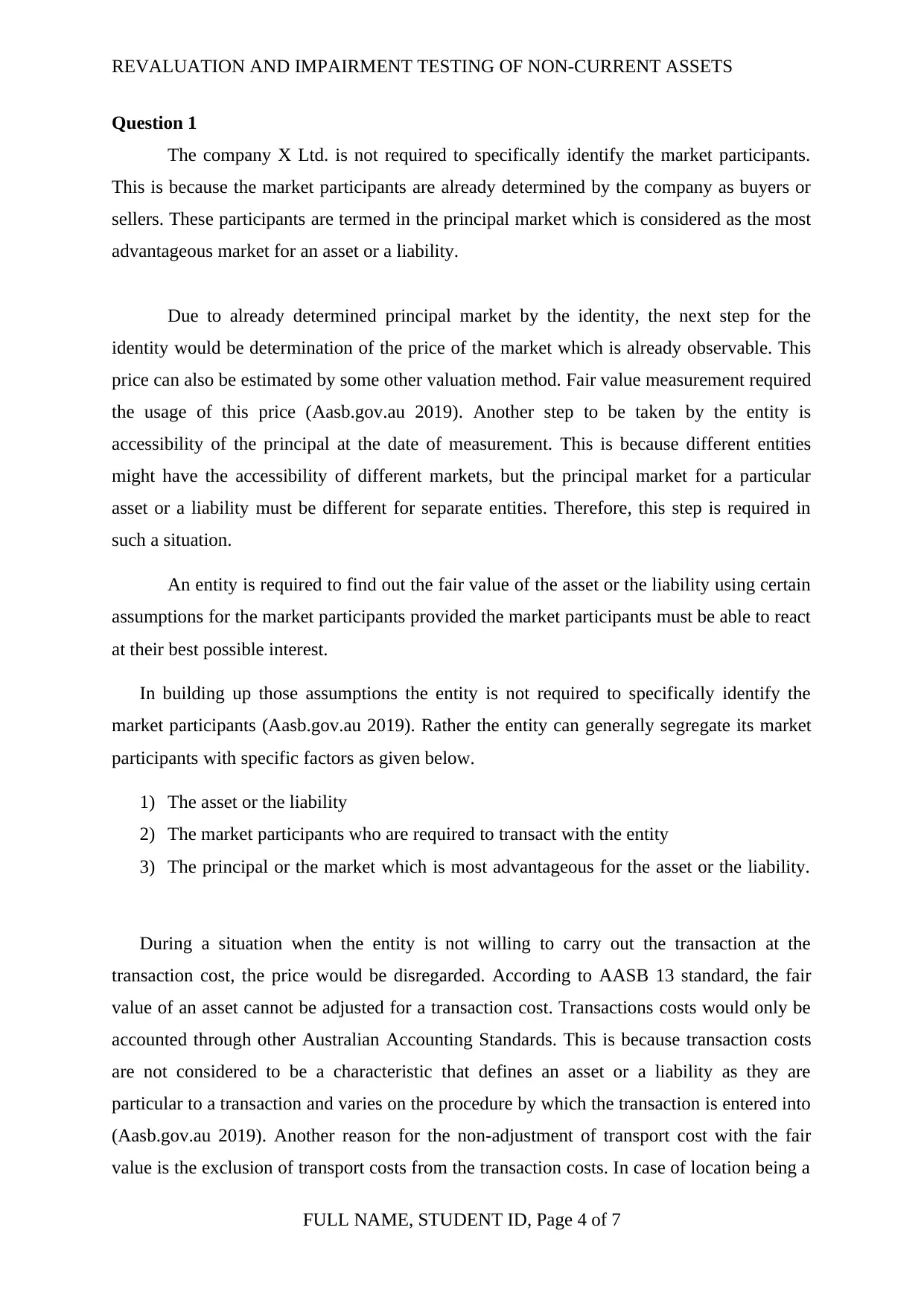
REVALUATION AND IMPAIRMENT TESTING OF NON-CURRENT ASSETS
Question 1
The company X Ltd. is not required to specifically identify the market participants.
This is because the market participants are already determined by the company as buyers or
sellers. These participants are termed in the principal market which is considered as the most
advantageous market for an asset or a liability.
Due to already determined principal market by the identity, the next step for the
identity would be determination of the price of the market which is already observable. This
price can also be estimated by some other valuation method. Fair value measurement required
the usage of this price (Aasb.gov.au 2019). Another step to be taken by the entity is
accessibility of the principal at the date of measurement. This is because different entities
might have the accessibility of different markets, but the principal market for a particular
asset or a liability must be different for separate entities. Therefore, this step is required in
such a situation.
An entity is required to find out the fair value of the asset or the liability using certain
assumptions for the market participants provided the market participants must be able to react
at their best possible interest.
In building up those assumptions the entity is not required to specifically identify the
market participants (Aasb.gov.au 2019). Rather the entity can generally segregate its market
participants with specific factors as given below.
1) The asset or the liability
2) The market participants who are required to transact with the entity
3) The principal or the market which is most advantageous for the asset or the liability.
During a situation when the entity is not willing to carry out the transaction at the
transaction cost, the price would be disregarded. According to AASB 13 standard, the fair
value of an asset cannot be adjusted for a transaction cost. Transactions costs would only be
accounted through other Australian Accounting Standards. This is because transaction costs
are not considered to be a characteristic that defines an asset or a liability as they are
particular to a transaction and varies on the procedure by which the transaction is entered into
(Aasb.gov.au 2019). Another reason for the non-adjustment of transport cost with the fair
value is the exclusion of transport costs from the transaction costs. In case of location being a
FULL NAME, STUDENT ID, Page 4 of 7
Question 1
The company X Ltd. is not required to specifically identify the market participants.
This is because the market participants are already determined by the company as buyers or
sellers. These participants are termed in the principal market which is considered as the most
advantageous market for an asset or a liability.
Due to already determined principal market by the identity, the next step for the
identity would be determination of the price of the market which is already observable. This
price can also be estimated by some other valuation method. Fair value measurement required
the usage of this price (Aasb.gov.au 2019). Another step to be taken by the entity is
accessibility of the principal at the date of measurement. This is because different entities
might have the accessibility of different markets, but the principal market for a particular
asset or a liability must be different for separate entities. Therefore, this step is required in
such a situation.
An entity is required to find out the fair value of the asset or the liability using certain
assumptions for the market participants provided the market participants must be able to react
at their best possible interest.
In building up those assumptions the entity is not required to specifically identify the
market participants (Aasb.gov.au 2019). Rather the entity can generally segregate its market
participants with specific factors as given below.
1) The asset or the liability
2) The market participants who are required to transact with the entity
3) The principal or the market which is most advantageous for the asset or the liability.
During a situation when the entity is not willing to carry out the transaction at the
transaction cost, the price would be disregarded. According to AASB 13 standard, the fair
value of an asset cannot be adjusted for a transaction cost. Transactions costs would only be
accounted through other Australian Accounting Standards. This is because transaction costs
are not considered to be a characteristic that defines an asset or a liability as they are
particular to a transaction and varies on the procedure by which the transaction is entered into
(Aasb.gov.au 2019). Another reason for the non-adjustment of transport cost with the fair
value is the exclusion of transport costs from the transaction costs. In case of location being a
FULL NAME, STUDENT ID, Page 4 of 7
Paraphrase This Document
Need a fresh take? Get an instant paraphrase of this document with our AI Paraphraser
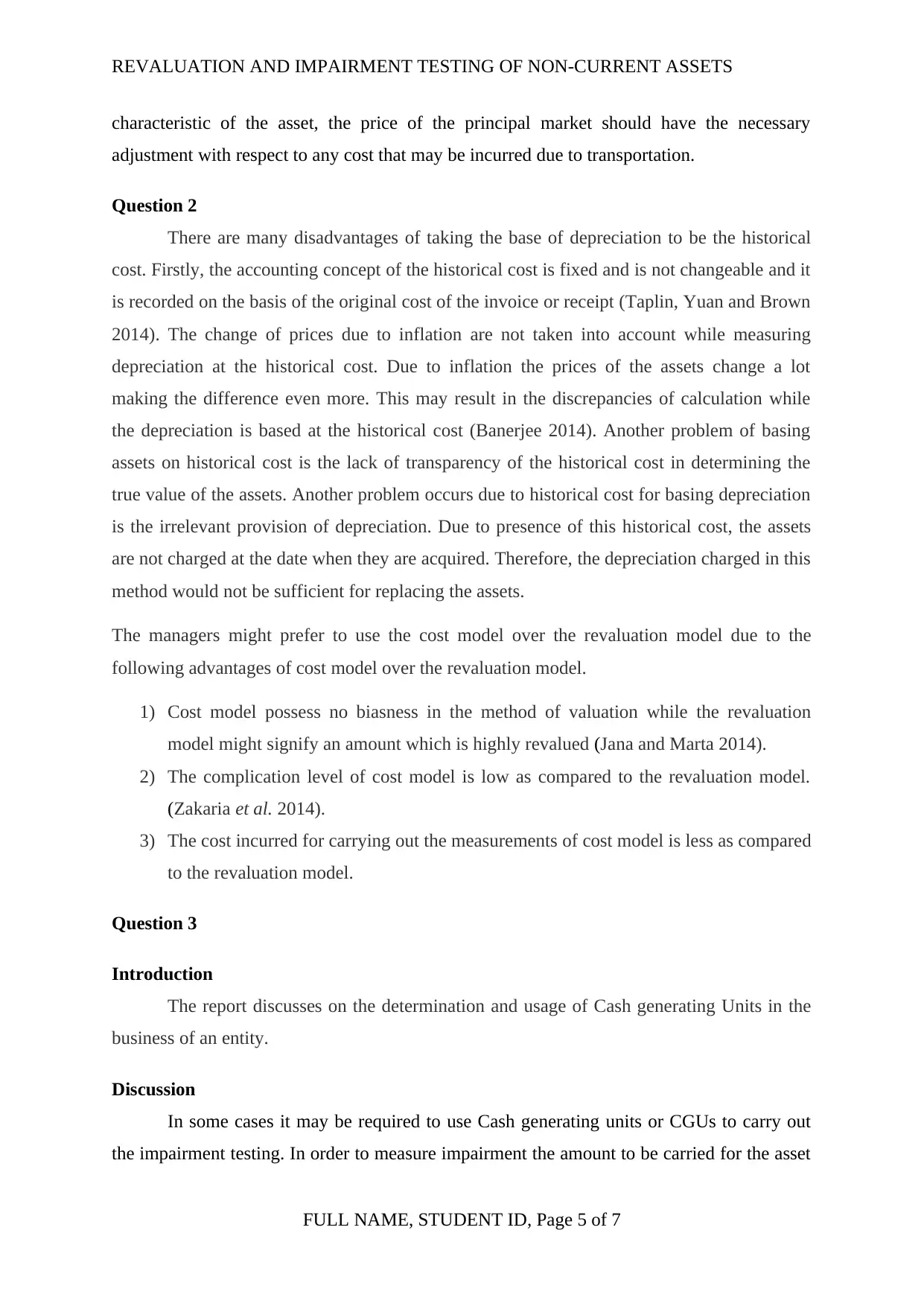
REVALUATION AND IMPAIRMENT TESTING OF NON-CURRENT ASSETS
characteristic of the asset, the price of the principal market should have the necessary
adjustment with respect to any cost that may be incurred due to transportation.
Question 2
There are many disadvantages of taking the base of depreciation to be the historical
cost. Firstly, the accounting concept of the historical cost is fixed and is not changeable and it
is recorded on the basis of the original cost of the invoice or receipt (Taplin, Yuan and Brown
2014). The change of prices due to inflation are not taken into account while measuring
depreciation at the historical cost. Due to inflation the prices of the assets change a lot
making the difference even more. This may result in the discrepancies of calculation while
the depreciation is based at the historical cost (Banerjee 2014). Another problem of basing
assets on historical cost is the lack of transparency of the historical cost in determining the
true value of the assets. Another problem occurs due to historical cost for basing depreciation
is the irrelevant provision of depreciation. Due to presence of this historical cost, the assets
are not charged at the date when they are acquired. Therefore, the depreciation charged in this
method would not be sufficient for replacing the assets.
The managers might prefer to use the cost model over the revaluation model due to the
following advantages of cost model over the revaluation model.
1) Cost model possess no biasness in the method of valuation while the revaluation
model might signify an amount which is highly revalued (Jana and Marta 2014).
2) The complication level of cost model is low as compared to the revaluation model.
(Zakaria et al. 2014).
3) The cost incurred for carrying out the measurements of cost model is less as compared
to the revaluation model.
Question 3
Introduction
The report discusses on the determination and usage of Cash generating Units in the
business of an entity.
Discussion
In some cases it may be required to use Cash generating units or CGUs to carry out
the impairment testing. In order to measure impairment the amount to be carried for the asset
FULL NAME, STUDENT ID, Page 5 of 7
characteristic of the asset, the price of the principal market should have the necessary
adjustment with respect to any cost that may be incurred due to transportation.
Question 2
There are many disadvantages of taking the base of depreciation to be the historical
cost. Firstly, the accounting concept of the historical cost is fixed and is not changeable and it
is recorded on the basis of the original cost of the invoice or receipt (Taplin, Yuan and Brown
2014). The change of prices due to inflation are not taken into account while measuring
depreciation at the historical cost. Due to inflation the prices of the assets change a lot
making the difference even more. This may result in the discrepancies of calculation while
the depreciation is based at the historical cost (Banerjee 2014). Another problem of basing
assets on historical cost is the lack of transparency of the historical cost in determining the
true value of the assets. Another problem occurs due to historical cost for basing depreciation
is the irrelevant provision of depreciation. Due to presence of this historical cost, the assets
are not charged at the date when they are acquired. Therefore, the depreciation charged in this
method would not be sufficient for replacing the assets.
The managers might prefer to use the cost model over the revaluation model due to the
following advantages of cost model over the revaluation model.
1) Cost model possess no biasness in the method of valuation while the revaluation
model might signify an amount which is highly revalued (Jana and Marta 2014).
2) The complication level of cost model is low as compared to the revaluation model.
(Zakaria et al. 2014).
3) The cost incurred for carrying out the measurements of cost model is less as compared
to the revaluation model.
Question 3
Introduction
The report discusses on the determination and usage of Cash generating Units in the
business of an entity.
Discussion
In some cases it may be required to use Cash generating units or CGUs to carry out
the impairment testing. In order to measure impairment the amount to be carried for the asset
FULL NAME, STUDENT ID, Page 5 of 7
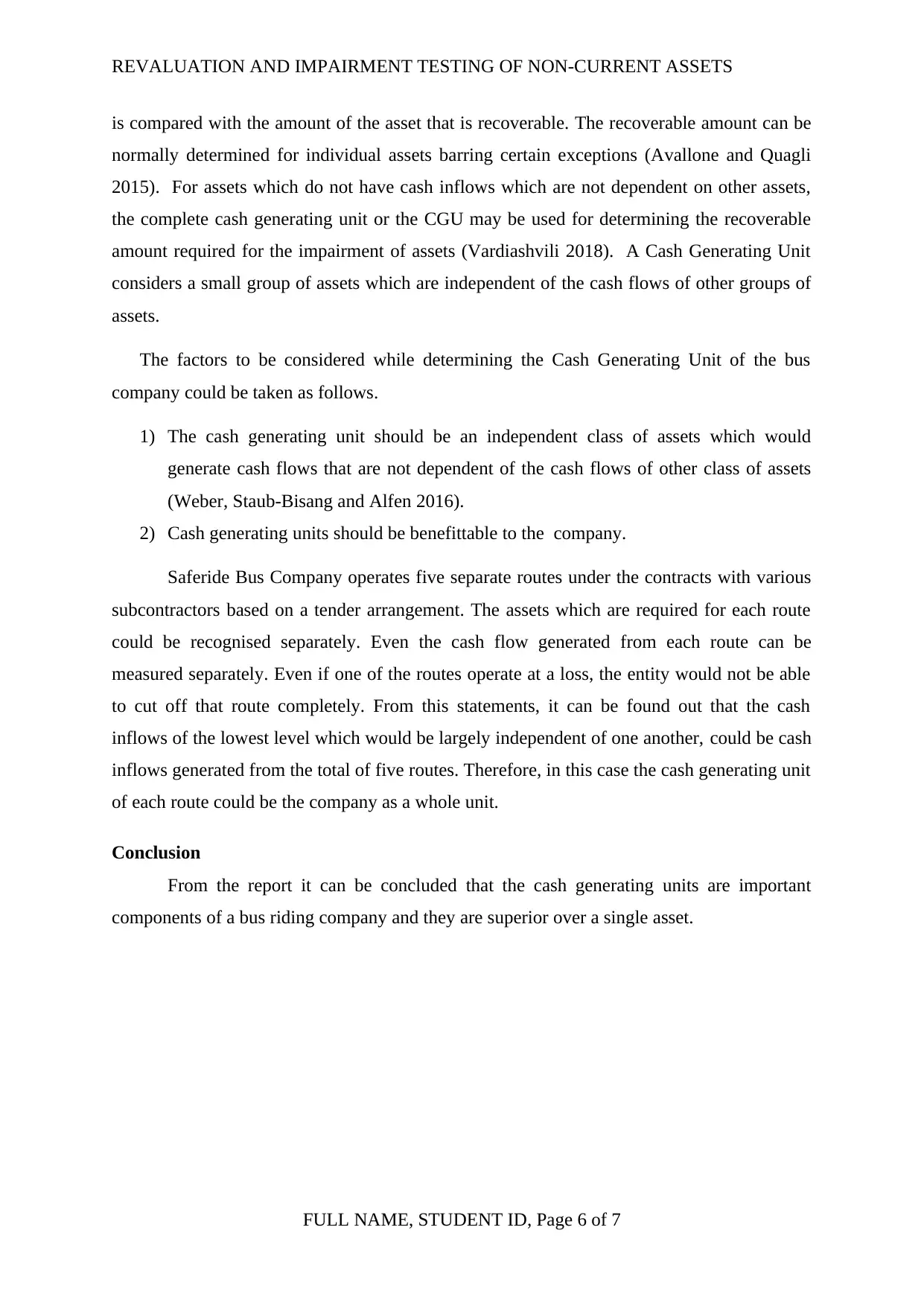
REVALUATION AND IMPAIRMENT TESTING OF NON-CURRENT ASSETS
is compared with the amount of the asset that is recoverable. The recoverable amount can be
normally determined for individual assets barring certain exceptions (Avallone and Quagli
2015). For assets which do not have cash inflows which are not dependent on other assets,
the complete cash generating unit or the CGU may be used for determining the recoverable
amount required for the impairment of assets (Vardiashvili 2018). A Cash Generating Unit
considers a small group of assets which are independent of the cash flows of other groups of
assets.
The factors to be considered while determining the Cash Generating Unit of the bus
company could be taken as follows.
1) The cash generating unit should be an independent class of assets which would
generate cash flows that are not dependent of the cash flows of other class of assets
(Weber, Staub-Bisang and Alfen 2016).
2) Cash generating units should be benefittable to the company.
Saferide Bus Company operates five separate routes under the contracts with various
subcontractors based on a tender arrangement. The assets which are required for each route
could be recognised separately. Even the cash flow generated from each route can be
measured separately. Even if one of the routes operate at a loss, the entity would not be able
to cut off that route completely. From this statements, it can be found out that the cash
inflows of the lowest level which would be largely independent of one another, could be cash
inflows generated from the total of five routes. Therefore, in this case the cash generating unit
of each route could be the company as a whole unit.
Conclusion
From the report it can be concluded that the cash generating units are important
components of a bus riding company and they are superior over a single asset.
FULL NAME, STUDENT ID, Page 6 of 7
is compared with the amount of the asset that is recoverable. The recoverable amount can be
normally determined for individual assets barring certain exceptions (Avallone and Quagli
2015). For assets which do not have cash inflows which are not dependent on other assets,
the complete cash generating unit or the CGU may be used for determining the recoverable
amount required for the impairment of assets (Vardiashvili 2018). A Cash Generating Unit
considers a small group of assets which are independent of the cash flows of other groups of
assets.
The factors to be considered while determining the Cash Generating Unit of the bus
company could be taken as follows.
1) The cash generating unit should be an independent class of assets which would
generate cash flows that are not dependent of the cash flows of other class of assets
(Weber, Staub-Bisang and Alfen 2016).
2) Cash generating units should be benefittable to the company.
Saferide Bus Company operates five separate routes under the contracts with various
subcontractors based on a tender arrangement. The assets which are required for each route
could be recognised separately. Even the cash flow generated from each route can be
measured separately. Even if one of the routes operate at a loss, the entity would not be able
to cut off that route completely. From this statements, it can be found out that the cash
inflows of the lowest level which would be largely independent of one another, could be cash
inflows generated from the total of five routes. Therefore, in this case the cash generating unit
of each route could be the company as a whole unit.
Conclusion
From the report it can be concluded that the cash generating units are important
components of a bus riding company and they are superior over a single asset.
FULL NAME, STUDENT ID, Page 6 of 7
⊘ This is a preview!⊘
Do you want full access?
Subscribe today to unlock all pages.

Trusted by 1+ million students worldwide
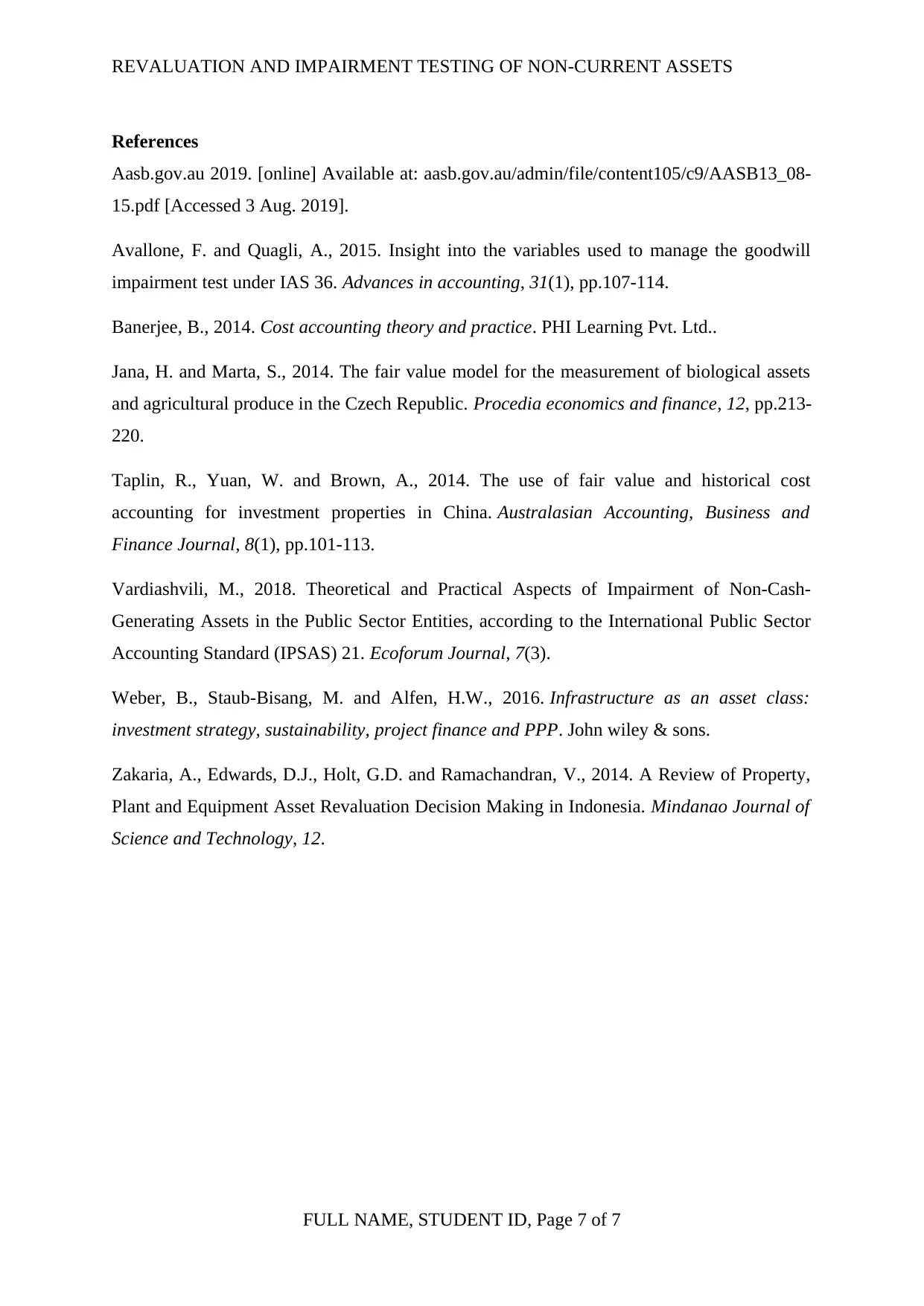
REVALUATION AND IMPAIRMENT TESTING OF NON-CURRENT ASSETS
References
Aasb.gov.au 2019. [online] Available at: aasb.gov.au/admin/file/content105/c9/AASB13_08-
15.pdf [Accessed 3 Aug. 2019].
Avallone, F. and Quagli, A., 2015. Insight into the variables used to manage the goodwill
impairment test under IAS 36. Advances in accounting, 31(1), pp.107-114.
Banerjee, B., 2014. Cost accounting theory and practice. PHI Learning Pvt. Ltd..
Jana, H. and Marta, S., 2014. The fair value model for the measurement of biological assets
and agricultural produce in the Czech Republic. Procedia economics and finance, 12, pp.213-
220.
Taplin, R., Yuan, W. and Brown, A., 2014. The use of fair value and historical cost
accounting for investment properties in China. Australasian Accounting, Business and
Finance Journal, 8(1), pp.101-113.
Vardiashvili, M., 2018. Theoretical and Practical Aspects of Impairment of Non-Cash-
Generating Assets in the Public Sector Entities, according to the International Public Sector
Accounting Standard (IPSAS) 21. Ecoforum Journal, 7(3).
Weber, B., Staub-Bisang, M. and Alfen, H.W., 2016. Infrastructure as an asset class:
investment strategy, sustainability, project finance and PPP. John wiley & sons.
Zakaria, A., Edwards, D.J., Holt, G.D. and Ramachandran, V., 2014. A Review of Property,
Plant and Equipment Asset Revaluation Decision Making in Indonesia. Mindanao Journal of
Science and Technology, 12.
FULL NAME, STUDENT ID, Page 7 of 7
References
Aasb.gov.au 2019. [online] Available at: aasb.gov.au/admin/file/content105/c9/AASB13_08-
15.pdf [Accessed 3 Aug. 2019].
Avallone, F. and Quagli, A., 2015. Insight into the variables used to manage the goodwill
impairment test under IAS 36. Advances in accounting, 31(1), pp.107-114.
Banerjee, B., 2014. Cost accounting theory and practice. PHI Learning Pvt. Ltd..
Jana, H. and Marta, S., 2014. The fair value model for the measurement of biological assets
and agricultural produce in the Czech Republic. Procedia economics and finance, 12, pp.213-
220.
Taplin, R., Yuan, W. and Brown, A., 2014. The use of fair value and historical cost
accounting for investment properties in China. Australasian Accounting, Business and
Finance Journal, 8(1), pp.101-113.
Vardiashvili, M., 2018. Theoretical and Practical Aspects of Impairment of Non-Cash-
Generating Assets in the Public Sector Entities, according to the International Public Sector
Accounting Standard (IPSAS) 21. Ecoforum Journal, 7(3).
Weber, B., Staub-Bisang, M. and Alfen, H.W., 2016. Infrastructure as an asset class:
investment strategy, sustainability, project finance and PPP. John wiley & sons.
Zakaria, A., Edwards, D.J., Holt, G.D. and Ramachandran, V., 2014. A Review of Property,
Plant and Equipment Asset Revaluation Decision Making in Indonesia. Mindanao Journal of
Science and Technology, 12.
FULL NAME, STUDENT ID, Page 7 of 7
1 out of 7
Related Documents
Your All-in-One AI-Powered Toolkit for Academic Success.
+13062052269
info@desklib.com
Available 24*7 on WhatsApp / Email
![[object Object]](/_next/static/media/star-bottom.7253800d.svg)
Unlock your academic potential
Copyright © 2020–2025 A2Z Services. All Rights Reserved. Developed and managed by ZUCOL.





